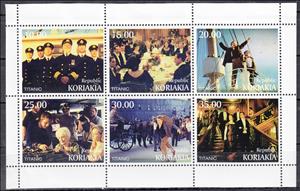Mini Sheet: Titanic (Cinderellas 1999)
Titanic (Cinderellas 1999)
01 January (Cinderellas ) within release Russia : Koriakia goes into circulation Mini Sheet Titanic face value 135 Russian ruble
| Mini Sheet Titanic in catalogues | |
|---|---|
| Colnect codes: | Col: RU-KR 1999-07 |
Mini Sheet is square format.
This item was illegally produced without the authorization of the postal administration inscribed on the stamps. They have no postal validity.Also in the issue Russia : Koriakia:
- Stamp - Agrodiaetus damon face value 3;
- Mini Sheet - Butterflies face value 10;
- Stamp - Dog face value 5;
- Stamp - Dog face value 5;
- Stamp - Dog face value 5;
- Stamp - Dog face value 5;
- Stamp - Dog face value 5;
- Stamp - Dog face value 5;
- Stamp - Dog face value 5;
- Stamp - Dog face value 5;
- Stamp - Dog face value 5;
- Stamp - Dog face value 5;
- Stamp - Dog face value 5;
- Stamp - Dog face value 5;
- Stamp - Dog face value 5;
- Stamp - Dog face value 5;
- Stamp - Dog face value 5;
- Stamp - Dog face value 5;
- Stamp - Dog face value 5;
- Stamp - Dog face value 5;
- Mini Sheet - Dogs face value 6*5;
- Mini Sheet - Dogs face value 6*5;
- Stamp - Dryas iulia face value 1;
- Stamp - Lycaena phlaeas face value 2;
- Stamp - Melitaea athalia face value 4;
- Mini Sheet - Actors face value 6*2.50;
- Mini Sheet - Chinese wall face value 45;
- Mini Sheet - Motorcycles face value 21;
- Mini Sheet - Titanic face value 135;
|
Data entry completed
53%
|
|
|---|---|
| Mini Sheet Titanic in digits | |
| Country: | Cinderellas |
| Date: | 1999-01-01 |
| Print: | Offset lithography |
| Emission: | Незаконный |
| Format: | Mini Sheet |
| Face Value: | 135 Russian ruble |
Mini Sheet Titanic it reflects the thematic directions:
Animals are multicellular, eukaryotic organisms of the kingdom Animalia (also called Metazoa). All animals are motile, meaning they can move spontaneously and independently, at some point in their lives. Their body plan eventually becomes fixed as they develop, although some undergo a process of metamorphosis later on in their lives. All animals are heterotrophs: they must ingest other organisms or their products for sustenance.
A disaster is a serious problem that happens over a period of time and causes so much harm to people, things, economies, or the environment that the affected community or society cannot handle it on its own. In theory, natural disasters are those caused by natural hazards, whereas human-made disasters are those caused by human hazards. However, in modern times, the divide between natural, human-made or human-accelerated disasters is more and more difficult to draw. In fact, all disasters can be seen as human-made, due to human failure to introduce appropriate emergency management measures
The horse (Equus ferus caballus) is one of two extant subspecies of Equus ferus. It is an odd-toed ungulate mammal belonging to the taxonomic family Equidae. The horse has evolved over the past 45 to 55 million years from a small multi-toed creature, Eohippus, into the large, single-toed animal of today. Humans began to domesticate horses around 4000 BC, and their domestication is believed to have been widespread by 3000 BC. Horses in the subspecies caballus are domesticated, although some domesticated populations live in the wild as feral horses. These feral populations are not true wild horses, as this term is used to describe horses that have never been domesticated, such as the endangered Przewalski's horse, a separate subspecies, and the only remaining true wild horse. There is an extensive, specialized vocabulary used to describe equine-related concepts, covering everything from anatomy to life stages, size, colors, markings, breeds, locomotion, and behavior.
Mammals are any vertebrates within the class Mammalia (/məˈmeɪli.ə/ from Latin mamma "breast"), a clade of endothermic amniotes distinguished from reptiles (including birds) by the possession of a neocortex (a region of the brain), hair, three middle ear bones and mammary glands. All female mammals nurse their young with milk, secreted from the mammary glands. Mammals include the largest animals on the planet, the great whales. The basic body type is a terrestrial quadruped, but some mammals are adapted for life at sea, in the air, in trees, underground or on two legs. The largest group of mammals, the placentals, have a placenta, which enables the feeding of the fetus during gestation. Mammals range in size from the 30–40 mm (1.2–1.6 in) bumblebee bat to the 30-meter (98 ft) blue whale. With the exception of the five species of monotreme (egg-laying mammals), all modern mammals give birth to live young. Most mammals, including the six most species-rich orders, belong to the placental group. The largest orders are the rodents, bats and Soricomorpha (shrews and allies). The next three biggest orders, depending on the biological classification scheme used, are the Primates (apes and monkeys), the Cetartiodactyla (whales and even-toed ungulates), and the Carnivora (cats, dogs, seals, and allies).
A ship is a large watercraft that travels the world's oceans and other sufficiently deep waterways, carrying passengers or goods, or in support of specialized missions, such as defense, research and fishing. Historically, a "ship" was a sailing vessel with at least three square-rigged masts and a full bowsprit. Ships are generally distinguished from boats, based on size, shape and load capacity.





